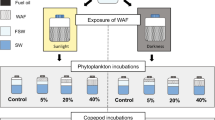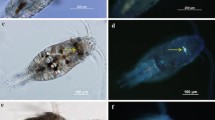Abstract
Here we evaluate the effects of two quantitatively very important components of the water soluble fractions of fuel oils (naphthalene and 1,2-dimethylnaphthalene, hereafter NAPH and C2-NAPH, respectively) on the survival, feeding and egg production rates, and viability of eggs of the coastal copepod Paracartia (Acartia) grani. Acute toxicity responses resulted in lethal concentrations (LC50) of 2,535 and 161 μg l−1 for NAPH and C2-NAPH, respectively, with no evidence of narcotic effects. Hydrocarbon-specific differences in the toxicity response indicate that sublethal effects (EC50) on feeding by C2-NAPH were likely driven by induced mortality, whereas NAPH has direct negative effects on feeding. Sublethal effects on egg production rates followed a similar detrimental pattern to the one exhibited by feeding rates, suggesting that the lower egg production rates were mediated by the decrease in feeding rates. At the exposure time tested (24 h), the 50% reduction effective concentrations (EC50) determined for sublethal effects were relatively high in comparison with hydrocarbons’ concentrations found under natural circumstances. Long exposure (4 days) of P. grani adults to the tested hydrocarbons at concentrations well below the recorded EC50, however, had no significant effects on feeding, egg production and hatching rates. The viability of the eggs was either not affected or only slightly influenced when healthy eggs were incubated under very high concentrations (up to 6,400 and 700 μg l−1 NAPH and C2-NAPH, respectively). The significance of the effects of oil spills on marine zooplankton communities is discussed in light of the results presented in this study.



Similar content being viewed by others
References
Albaigés J, Bayona JM (2003) El fuel. In: La huella del fuel. Ensayos sobre el Prestige. Fundación Santiago Rey Fernández-Latorre AC, Spain (ed). A Coruña. Spain
Ayukai T, Nishizawa S (1986) Defecation rate as a possible measure of ingestion rate of Calanus pacificus (Copepoda: Calanoida). Bull Plankton Soc. Japan/Nihon Purankuton Gakkaiho 33:3–10
Barata C, Baird DJ, Medina M, Albalat A, Soares AMVM (2002) Determining the ecotoxicological mode of action of toxic chemicals in meiobenthic marine organisms: stage-specific short tests with Tisbe battagliai. Mar Ecol Prog Ser 230:183–194
Barata C, Calbet A, Saiz E, Ortiz L, Bayona J (2005) Predicting single and mixture toxicity of petrogenic polycyclic aromatic hydrocarbons to the copepod Oithona davisae. Environ Toxicol Chem 24:210–217
Barbier M, Joly D, Saliot A, Tourres D (1973) Hydrocarbons from sea water. Deep-Sea Res 20:305–314
Berdugo V, Harris RP, O’Hara SC (1977) The effect of petroleum hydrocarbons on reproduction of an estuarine planktonic copepod in laboratory cultures. Mar Pollut Bull 8:138–143
Berman MS, Heinle DR (1980) Modification of the feeding behavior of marine copepods by sub-lethal concentrations of water-accommodated fuel oil. Mar Biol 56:59–64
Calbet A, Alcaraz M (1996) Effects of constant and fluctuating food supply on egg production rates of Acartia grani (Copepoda: Calanoida). Mar Ecol Prog Ser 140:33–39
Corner EDS (1978) Pollution studies with marine plankton. Part 1. Petroleum hydrocarbons and related compounds. Adv Mar Biol 15:289–380
Corner EDS, Harris RP, Kilvington CC, O’Hara SCM (1976) Petroleum compounds in the marine food web: short-term experiments on the fate of naphthalene in Calanus. J Mar Biol Assoc UK 56:121–133
Cowles TJ, Remillard JF (1983) Effects of exposure to sublethal concentrations of crude oil on the copepod Centropages hamatus. 1. Feeding and egg production. Mar Biol 78:45–51
Doval MD, Moroño A, Pazos Y, Lopez A, Madriñan M, Cabanas JM, Maneiro J (2006) Monitoring dissolved aromatic hydrocarbons in Rias Baixas embayments (NW Spain) after Prestige oil spills: relationship with hydrography. Est Coast Shelf Sci 67:205–218
Freire J, Labarta U (2003) Impactos sobre los recursos y ecosistemas marinos. In: La huella del fuel. Ensayos sobre el Prestige. Fundación Santiago Rey Fernández-Latorre AC, Spain (ed) A Coruña, Spain
Guerrero F, Rodríguez V (1997) Estimates of secondary production in a co-existent group of Acartia species (Copepoda, Calanoida). Crustaceana 70:584–593
Harris RP, Berdugo V, O’Hara SCM, Corner EDS (1977) Accumulation of 14C-1-Naphthalene by an oceanic and an estuarine copepod during long-term exposure to low-level concentrations. Mar Biol 42:187–195
Hazzard SE, Kleppel GS (2003) Egg production of the copepod Acartia tonsa in Florida Bay: role of fatty acids in the nutritional composition of the food environment. Mar Ecol Prog Ser 252:199–206
Law RJ, Dawes VJ, Woodhead RJ, Matthiessen P (1997) Polycyclic aromatic hydrocarbons (PAH) in seawater around England and Wales. Mar Pollut Bull 34:306–322
Lee WY, Nicol JAC (1977) The effects of the water soluble fractions of no. 2 fuel oil on the survival and behaviour of coastal and oceanic zooplankton. Environ Bull 12:279–292
Lutz RV, Marcus NH, Chanton JP (1992) Effects of low oxygen concentrations on the hatching and viability of eggs of marine copepods. Mar Biol 114:241–247
Lutz RV, Marcus NH, Chanton JP (1994) Hatching and viability of copepod eggs at two stages of embryonical development: anoxic/hypoxic effect. Mar Biol 119:199–204
Marcus NH (1996) Ecological and evolutionary significance of resting eggs in marine copepods: past, present and future studies. Hydrobiologia 320:141–152
Medina M, Barata C, Telfer R, Baird DJ (2002) Age- and sex-related variation in sensitivity to the pyrethroid cypermethrin in the marine copepod Acartia tonsa Dana. Archiv Environ Contam Toxicol 42(1):17–22
Offenheimer CH, Gunkel W, Gassmann G (1977) Microorganisms and hydrocarbons in the North Sea during July–August 1975. In: Proceedings of the 1977 Oil Spill Conference (Prevention, Behavior, Control, Cleanup), New Orleans, Louisiana, March 8–10
Ott FS, Harris RP, O’Hara SCM (1978) Acute and sublethal toxicity of naphthalene and three methylated derivatives to the estuarine copepod, Eurytemora affinis. Mar Environ Res 1:49–58
Paquet F, Lacaze JC (1990) Effect of photo-oxidation on the toxicity of a crude oil: impact on the larval production of the copepods Tigriopus brevicornis. J Rech Oceanogr 15:72–77
Pavletic Z, Munjko I, Jardas J, Matoricken I (1975) Quelques observations sur la pollution verticale de la mer par les huiles minérales et les phénols dans l’Adriatique centrale et méridionale faites à l’automne 1971–1972. In: IIes Journées d’Etudes sur les Pollutions Marines, Monaco, 6–7 December 1974
Razouls C, de Bovée F, Desreumaux N (2005) Diversité et répartition géographique chez les Copépodes planctoniques marins. http://www.copepodes.obs-banyuls.fr
Saiz E, Calbet A, Trepat I, Irigoien X, Alcaraz M (1997) Food availability as a potential source of bias in the egg production method for copepods. J Plankton Res 19:1–14
Singer SC, Lee RF (1977) Mixed function oxidase activity in blue crab, Callinectes sapidus: tissue distribution and correlation with changes during molting and development. Biol Bull Mar Biol Lab, 153:377–404
Tester PA, Turner JT (1990) How long does it take copepods to make eggs? J Exp Mar Biol Ecol 141:169–182
Wade TL, Q JG (1975) Hydrocarbons in the Sargasso Sea surface microlayer. Mar Pollut Bull 6:54–57
Witt G (1995) Polycyclic aromatic hydrocarbons in water and sediments of the Baltic Sea. Mar Pollut Bull 31:237–248
Acknowledgments
This study was funded by the MCyT Spanish project VEM2003-20037. Carlos Barata and Albert Calbet were supported by a Ramón y Cajal contract from MCyT. We thank J. Movilla and E. Vergara for their assistance during the experiments, and three anonymous reviewers for helpful comments and suggestions.
Author information
Authors and Affiliations
Corresponding author
Additional information
Communicated by S.A. Poulet, Roscoff.
Rights and permissions
About this article
Cite this article
Calbet, A., Saiz, E. & Barata, C. Lethal and sublethal effects of naphthalene and 1,2-dimethylnaphthalene on the marine copepod Paracartia grani . Mar Biol 151, 195–204 (2007). https://doi.org/10.1007/s00227-006-0468-0
Received:
Accepted:
Published:
Issue Date:
DOI: https://doi.org/10.1007/s00227-006-0468-0




